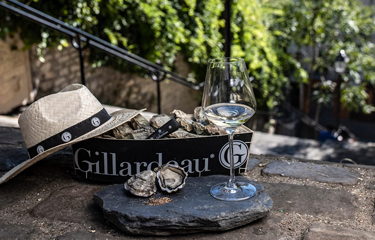Demand for Irish oysters is soaring in China, but some are being relabeled as French by rogue traders looking to cash in on the pricing premium enjoyed by the French-based Gillardeau company in the Chinese market.
A Chinese trader was jailed recently for reboxing Irish oysters with the Gillardeau brand. Gillardeau oysters are produced by the family of the same name in western France, though the firm also farms oysters in the south of Ireland.
The Gillardeau name has become a byword for sophistication in Chinese dining circles, giving rise to a black market trade in (non-Gillardeau) Irish oysters being packaged and sold illegally as the real French product, said Jack Yuan, chief executive at Hong Kong-based trading firm Whatfresh Ltd., which also supplies the mainland market.
“Chinese middlemen buy one box and produce two others by switching in less-expensive oysters and using a laser-engraving machine to replicate the ‘G’ laser stamp used by Gillardeau to verify their products,” Yuan told SeafoodSource.
A group of such counterfeiters were caught by mainland Chinese police in 2019 for breaking local counterfeiting law, said Yuan, “but they remain a problem.”
The counterfeiters typically use Irish oysters which – unlike New Zealand or local Chinese oysters – look similar to the Gillardeau, then resell them at a 30 to 50 percent mark-up.
“The fraudsters are a problem for legitimate traders because they undercut on price,” Yuan said.
The problem is partly down to Irish oyster exporters not focusing sufficiently on branding in China to ensure Irish oysters enjoy prestige comparable to the Gillardeau name in local markets, according to Yuan.
“Their product lacks the branding power and hence is being viewed as a cheaper alternative to French oysters, or being misused as counterfeits,” he said.
It’s a problem that’s also been recognized by Irish oyster exporters, such as Des Moore of Irish oyster exporter Bells Isle Seafood, who ships all his oysters in branded wooden boxes.
“About one in two queries I get are from people who want product in 20-kilogram polystyrene boxes. This normally is to re-box as fake Gillardeau. One query lately was a company who had registered a ‘Gilliardiau’ brand just spelt differently [from Gillardeau], but again I refused,” Moore said. “I know people in Ireland selling regularly big oysters in polystyrene boxes and I know in my own mind where they are going.”
The quality of the Irish product is “fairly close” to French oysters, said Yuan. Indeed several major French producers farm oysters in Ireland and move them to “claires” or ponds in France in order to adjust the taste prior to exporting.
Moore said Ireland’s export agency, Bord Bia, needs to leverage its own Origin Green marketing slogan and “should insist product is boxed in its own branded Irish wooden box” rather than allowing Irish oyster exporters to ship in unbranded polystyrene boxes.
“It serves nobody well apart from the rogue trader,” he said. “I would have thought this practice is in decline, as the consequences in China can be severe.”
Conor O’Sullivan, Bord Bia’s representative in Shanghai, told SeafoodSource his office has “heard of cases in the past where Irish oysters bought locally are then sold as French.” When discovered, these operators are punished by the local authorities, he said.
“Obviously, we don’t deal with these businesses nor do we want Ireland to be associated with them in any way,” he said.
O’Sullivan agreed that Irish oysters need to be branded better in China.
“Promoting the premium quality of Irish oysters is a key focus for our seafood activity in China. Ireland is already the number-two supplier of oysters to China, after France. We are finding that consumers and restaurant owners are increasingly recognizing Irish as an excellent producer of oysters, which is strengthening our position relative to the established brands,” he said.
Donegal, Ireland-based Bells Isle Seafood, which currently ships 3.5 tons of oysters per week to China, depends on buyers in Beijing and Shanghai for most of its sales and has seen a post-COVID surge in demand.
“Airline frequency and dependability are the main issue to ensuring a steady return to pre-COVID levels, but there is a feeling that there’s going to be a large demand in coming months,” Moore said. “I hope nothing happens to disturb this.”
O’Sullivan said Bord Bia has “many plans” to promote Irish oysters this year in Chinese foodservice venues and in the local media.
“For example, later this month we are running a whiskey-oyster pairing promotion across several locations in Shanghai,” he said. “This is in addition to general promotion to help strengthen the image of Ireland as a premium source of seafood.”
To combat the counterfeit problem, Whatfresh Ltd. plans to launch a QR code tracing program later this month. Yuan said it will help oyster producers to brand their goods and give restaurant and consumers confidence in oyster authenticity and its freshness.”
Whatfresh’s traceability program is intended to supplement health inspections conducted by Chinese and Hong Kong health authorities, Yuan said.
“In China, any imported oysters must go through the COVID-19 tests and a sanitization process, and vendors must show documents proving this, or they will be fined heavily,” he said. “The Hong Kong CFS [Centre for Food Safety] has also increased its rate of COVID-19 tests on imported oysters.”
Meanwhile, other sanitary issues facing imported oysters have become less of an issue. Detection of norovirus, which forced the suspension of European oyster imports into China in 2017, has decreased, said Yuan, because oyster farmers have become more proactive in avoiding shipments where norovirus might be a problem.
“Norovirus is usually a winter problem, [as] the water moves less,” he said.
Photo courtesy of Maison Gillardeau







